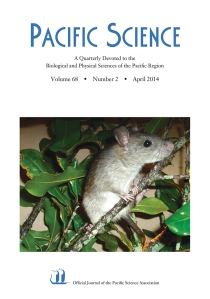 Biology and Impacts of Pacific Island Invasive Species. 11. Rattus rattus, the Black Rat (Rodentia: Muridae)
Biology and Impacts of Pacific Island Invasive Species. 11. Rattus rattus, the Black Rat (Rodentia: Muridae)
Aaron B. Shiels, William C. Pitt, Robert T. Sugihara, and Gary W. Witmer, 145
Abstract: The black rat, roof rat, or ship rat (Rattus rattus L.) is among the most widespread invasive vertebrates on islands and continents, and it is nearly ubiquitous on Pacific islands from the equatorial tropics to approximately 55 degrees latitude north and south.It survives well in human-dominated environments, natural areas, and islands where humans are not present. Rattus rattus is typically the most common invasive rodent in insular forests. Few vertebrates are more problematic to island biota and human livelihoods than R. rattus; it is well known to damage crops and stored foods, kill native species, and serve as a vector for human diseases. Rattus rattus is an omnivore, yet fruit and seed generally dominate its diet, and prey items from the ground to the canopy are commonly at risk and exploited as a result of the prominent arboreal activity of R. rattus. Here we review the biology of this invasive species and its impacts on humans and the insular plants and animals in the Pacific. We also describe some of the past management practices used to control R. rattus populations on islands they have invaded.
Ecological Role of Common Minke Whales in the Southwestern East Sea (Sea of Japan) Ecosystem during the Postcommercial Whaling Moratorium Period
Kyung-Jun Song and Chang Ik Zhang, 185
Abstract: Structure of the southwestern East Sea ecosystem and role of common minke whales (Balaenoptera acutorostrata) in this ecosystem during the postcommercial whaling moratorium (post-CWM) period (1986–2007) were examined using an Ecopath model. Results showed that catch and biomass of common squid was highest in this ecosystem (catch, 0.302 t/km2; biomass, 1.031 t/km2). Although this ecosystem consists of primary producers, primary consumers, secondary consumers, and terminal consumers, most taxonomic groups were classified as secondary consumers. Common minke whales were classified as terminal consumers along with apex predators. Trophic level of common minke whales in this ecosystem was estimated at 3.34, and mean trophic level of this ecosystem was estimated as 2.91. Relative contribution of common squid to total energy flow at trophic level III, which includes common minke whales, was highest (72.0%). However, relative contribution of common minke whales at this trophic level was low (1.3%) compared with other taxonomic groups. This study is one of the first to address anthropogenic impacts (commercial whaling) on the trophic role of common minke whales in the East Sea, and it could potentially be used to understand the importance of common minke whales to this ecosystem within a context of potential biological removal (PBR).
Genetic Diversity and Population Structure of Pronghorn Spiny Lobster Panulirus penicillatus in the Pacific Region
Muhamad Fadry Adbullah, Seinen Chow, Mitsuo Sakai, Jin-Hua Cheng, and Hideyuki Imai, 197
Abstract: Adult specimens of Panulirus penicillatus were collected from localities distributed in Japan: Hachijojima Island, Ryukyu Archipelago (Amamioshima, Okinawajima, Ishigakijima); Taiwan: Taitung; Indonesia: Java Sea and Gebe Island; French Polynesia: Moorea Island; and Ecuador: Isabela Island. Phyllosoma larval specimens were collected from the western sea of the Galápagos Islands. In total, 569–570 nucleotide sequences were analyzed from the mtDNA control region of 480 individuals. Almost all individuals had a unique haplotype. Intrapopulation haplotype (h) and nucleotide (π) diversities were high for each locality, ranging h = 0.9996–1.0000 and π = 0.0255–0.0448. A mismatch distribution of pairwise differences between haplotypes indicated that P. penicillatus does not fit the sudden population expansion model. Analysis of molecular variance (AMOVA) shows a clear genetic difference between two regions (western/central Pacific and eastern Pacific). High gene flow was found within localities in the western/central Pacific region, probably resulting from an extended planktonic larval stage and prevailing ocean currents. In this study we detected genetic structure between eastern Pacific populations and western Pacific populations, indicating that despite the nearly 1-yr larval period for this species, larvae generally do not pass over the East Pacific Barrier.
Changes in Structure and Function of Fish Assemblages along Environmental Gradients in an Intensive Agricultural Region of Subtropical Taiwan
Shin-Jou Lin, Shan-Te Tsai, Jun-Hun Lin, Koa-Jen Jong, and Yi-Kuang Wang, 213
Abstract: Intensive agriculture has degraded streams in subtropical Taiwan, but agricultural impacts on fish assemblages are not well studied. The goal of this study was to understand changes in structure and function of fish assemblages along environmental gradients in an agricultural region of South-central Taiwan. Nineteen sites in the hill and upper plain regions were selected for fish sampling during the base flow period. Water chemistry analyses and rapid habitat assessment were also conducted. Cluster analysis separated fish assemblages into four assemblage groups and a single site. A redundancy analysis (RDA) showed that environmental variables explained 73.9% of species variance. RDA axis 1 represented a habitat-diversity, cover, and nutrient gradient, whereas RDA axis 2 represented a complex riparian condition gradient. Relative abundances of dominant fish species and assemblage groups were related to water and habitat variables. Trophic and tolerance guilds were correlated with RDA axes. Number of fish species increased with decreasing elevation. Both structure and function of fish assemblages changed with water and habitat gradients in these subtropical agricultural streams.
Characterization and Conservation Concerns of Green Turtles (Chelonia mydas) Nesting in Hong Kong, China
Connie Ka-yan Ng, Peter H. Dutton, Simon Kin-fung Chan, Ka-shing Cheung, Jian-wen Qiu, and Ya-nan Sun, 231
Abstract: Hong Kong has one of the last remaining nesting populations of endangered green turtles (Chelonia mydas) in southern China. Because nesting individuals are vital to sustain populations, this study characterizes and reports essential baseline information about nesting pattern, postnesting movement, and genetic composition of green turtles nesting in Hong Kong to provide a basis for effective scientific-based management of this migratory species. The number of nesters observed in Hong Kong was relatively low compared with other rookeries in southern China, but the nesting pattern in terms of clutch size and internesting interval was comparable with that of other nearby rookeries. These nesters are likely a remnant of a small population previously depleted as a result of historical harvesting of eggs in Hong Kong. Based on available DNA sequences and literature, we identified two mtDNA haplotypes, CmP18 (which is also common in the rookery in Taiwan) and a novel endemic haplotype (CmP116). We found significant differentiation based on haplotype frequencies between populations in Hong Kong and Lanyu, Taiwan, indicating that these nesting populations are demographically isolated. Loss of these populations would therefore result in loss of genetic diversity for this species in the region. Satellite tracking of the local nesters revealed postnesting movement to foraging habitats in Vietnam and Hainan Island. International cooperation and consistent dedicated research are of paramount importance to conservation and recovery of green turtle assemblages in the region.
Living Brachiopods from French Polynesia, Central Pacific, with Descriptions of Two New Species
Maria Aleksandra Bitner, 245
Abstract: Six species of recent brachiopods have been identified in material collected during the French Tarasoc Expedition to the Tarava Seamounts and the Society and Tuamotu Islands, French Polynesia, in 2009. Two of them, Frenulina sanguinolenta (Gmelin, 1790) and Thecidellina maxilla (Hedley, 1899), have already been reported from the studied region. Two species, Discradisca sparselineata (Dall, 1920) and Septicollarina zezinae Bitner, 2009, are reported for the first time from French Polynesia, and two other species are described as new, Dallithyris tahitiensis Bitner, n. sp., and Annuloplatidia curiosa Bitner, n. sp., although the latter species was already recorded from French Polynesia, ascribed to a different taxon. When compared with the brachiopod fauna from the southwestern Pacific, that of French Polynesia is taxonomically depauperate, which might reflect the younger geological age of the islands of the central Pacific.
Persistence of Native Trees in an Invaded Hawaiian Lowland Wet Forest: Experimental Evaluation of Light and Water Constraints
Jodie R. Schulten, T. Colleen Cole, Susan Cordell, Keiko M. Publico, Rebecca Ostertag, Jaime E. Enoka, and Jené D. Michaud, 267
Abstract: Hawaiian lowland wet forests are heavily invaded and their restoration is most likely to be successful if native species selected for restoration have efficient resource-use traits. We evaluated growth, survival, and ecophysiological responses of four native and four invasive species in a greenhouse experiment that simulated reduced light and water conditions commonly found in invaded field conditions. Our results show that light is a more important limiting resource than water for all species. Specifically, values for photosynthesis, light compensation point, light saturation point, stomatal conductance, leaf mass per area, relative growth rate, and photosynthetic nitrogen use efficiency were all greater under high-light conditions than they were under low-light conditions. In contrast, water limitation negatively affected only stomatal conductance and δ13C. Our results also show that responses to light were species-specific rather than related to whether species were native or nonnative. We also tested restoration potential of top-performing native species under field conditions in a Hawaiian lowland wet forest by comparing relative growth and mortality rates in both invaded (low-light) plots and in plots from which invasive species had been removed (high-light conditions). Of the native species, Myrsine lessertiana and Psychotria hawaiiensis had highest survival and growth rates in low-light plots after 4 yr, and Metrosideros polymorpha showed 100% mortality under the same conditions. Under low light, M. lessertiana and P. hawaiiensis survived and grew at rates similar to those of invasive species in both field and greenhouse and thus represent suitable candidates for restoration in invaded Hawaiian lowland wet forests.
New Information and Reappraisals Concerning Some Alien and Indigenous Snake Records from the Federated States of Micronesia and the Mariana Islands
Donald W. Buden, Kevin de Queiroz, Johan Van Rooijen, Derek W. Stinson, Gary J. Wiles, and Sabrino Robert, 287
Abstract: New information is presented on old records of four species of snakes from four different islands in Micronesia. A record of Dendrelaphis caudolineatus from Saipan is reexamined and the specimen reidentified as D. philippinensis, and a snake from Pohnpei previously recorded only as an unidentified species of Dendrelaphis is identified as D. punctulatus striolatus. We also provide supplementary data on circumstances surrounding records of a brown tree snake, Boiga irregularis, from Chuuk, and a yellow-bellied sea snake, Hydrophis platurus (Pelamis platura), from Kosrae.
Osmundea purepecha, n. sp. (Rhodophyta: Ceramiales), from the Pacific Tropical Coast of Mexico, Based on Morphological and Molecular Data
Abel Sentíes, A. Catalina Mendoza-González, Luz Elena Mateo-Cid, Jhoana Díaz-Larrea, Gerardo A. Ceballos-Corona, and Mutue T. Fujii, 295
Abstract: Osmundea purepecha Sentíes, Mendoza-González & Mateo-Cid, n. sp., is proposed from Zapote, Michoacán, tropical Mexican Pacific coast, on the basis of comparative morphology and rbcL sequence analysis. This species has characteristics typical of the genus Osmundea, including two pericentral cells per axial segment and male gametophytes with a “filament” type reproductive structure. Spermatangial branches are simple, terminating in one or two spherical sterile cells, developing in pocket-shaped pits located at tips of branchlets. Phylogenetic position of this species was inferred by analysis of chloroplast-encoded rbcL gene sequences from 33 taxa, including one member of the Ceramiaceae as an outgroup. The Mexican Pacific sample, from Zapote, formed a distinctive and well-supported basal clade segregated from other Osmundea species. Osmundea purepecha, n. sp., is morphologically and genetically distinct from other Osmundea species, supporting the assignment of this new taxon.
Association Affairs, 305




